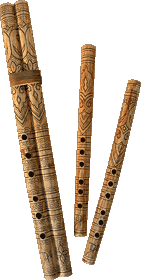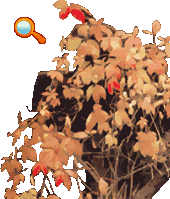KONCOVKA [kontsovka] is an overtone fipple flute, has no finger holes and is two to three feet in length. The player opens and closes the far end of the tube while playing in the upper harmonics to create melodies. The tones are from the so called natural harmonic scale.
While such instruments are almost extinct in almost all other cultures, in Slovakia is koncovka (overtone flute) still widely popular. (Koncovka audio sample:  play, play,  download) download)
 Another "special" Slovak folk instrument is DVOJACKA [dvoyatschka]. Another "special" Slovak folk instrument is DVOJACKA [dvoyatschka].
It is a intricate combination of familiar 6-hole shepherd pipe and koncovka (overtone flute). The dvojacka combines the playing techniques of overtone flute (koncovka) and shepherd pipe (pistalka). The dvojacka (double shepherd pipe) sounds especially beautiful, because the player can play a drone or harmony at the same time as the melody. A performance commonly begins using only the tube with holes to state the melody. The harmony or drone side is then added for effect on every other performance of the melody.
PISTALKA is an end blown fipple flute about one feet in length with six holes bored along the side held upwards. The player blows through the fipple on the top end and covers the finger holes with the first three fingers of each hand.
FUJARA [fuyara] is basically a very large overtone flute in bass possition, with additional 3 side holes, has the same basic overtone scale as koncovka, and additional tones are gained by opening the side holes. Fujara is capable to overblow easily to over 11 overtone levels. Each fujara maker creates his own design to carve or stain onto the outside of the instrument.
The instrument itself consists of two carved wooden tubes connected at the top by a short air tunnel. The smaller tube does not produce tone but serves to carry the air up and across to the longer main tube that has the fipple and three finger holes.
The player holds the fujara upright and blows into the shorter tube, often assisted by a small, carved mouthpiece.
Playing technique of the Slovak folk woodwind instruments:
The Koncovka (overtone flute), a holeless flute, produces it's scale by overblowing to overtones and shading them with a finger on the end to produce it's scale. The familiar Shepherd pipe (six hole flute) also overblows, but just to the 1st overtone and uses its 6 holes to produce it's scale. The Fujara (bass overtone flute) is the most dynamic flute and easily overblows to over 11 overtone levels. Fujara simply extends this phenomenon with its three holes to play also more intricate melodies. |




 Another "special" Slovak folk instrument is
Another "special" Slovak folk instrument is